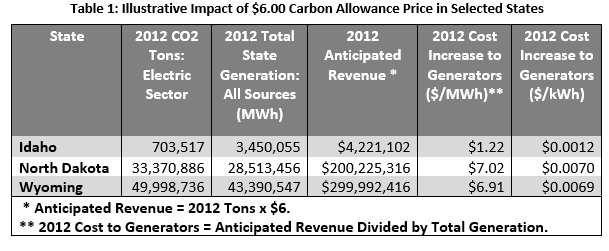As they consider how to comply with EPA’s Clean Power Plan (CPP), many states are reaching a growing consensus that mass-based programs with regional trading—“cap-and-trade”—could drive compliance costs down.
A related mass-based approach—one with which states may be less familiar—is known as “cap-and-invest.” It uses the revenues from allowance sales to achieve further emissions reductions by investing in state clean energy programs. The most prominent example of this is the Regional Greenhouse Gas Initiative (RGGI), an electric sector CO2 emissions reduction program that has been in operation since 2009.
When Northeastern state energy and air regulators designed what would become RGGI, they wrestled with the same issues that states face today as they evaluate CPP compliance. The federal acid rain cap-and-trade program for sulfur dioxide (SO2) emissions served as a model for RGGI design, and although it wasn’t said outright, RGGI staff’s original design impulse can be characterized as, “we did it with SO2; let’s do it with CO2.” In other words, they started where regulators find themselves today, thinking, “let’s cap emissions to get the environmental result we want and trade allowances to keep costs down.”
State decision makers generally appreciate the merits of cap-and-trade, but there is far less understanding of the benefits of cap-and-invest. The two are quite different, and below are some of the reasons why many consider cap-and-invest a wise way to address electric sector CO2 emissions.
We Did It with SO2; Let’s Do It with CO2
The RGGI states built on the cap-and-trade idea, but modified it because controlling CO2 is not like controlling SO2. CO2 has no affordable control technologies like SO2 (e.g., scrubbers), so the states turned to state clean energy programs that were already avoiding CO2 emissions.
The RGGI states were also concerned about the potential for their program to raise electricity rates with no attendant cost protection for consumers. Furthermore, the states came to understand that even with free allocation of allowances to generators, as with the SO2 program, generators would include the opportunity cost of the free allowances in their electricity prices, raising consumer costs anyway.
With this in mind, RGGI states chose to distribute allowances through an auction in order to raise money to help consumers pay for energy efficiency measures that would insulate them from price hikes. When RGGI states modeled the use of auction revenue to expand state energy efficiency programs, they learned doing so would reduce residential bills by 12 percent, industrial bills by 5 percent, the need for new fossil capacity by 33 percent, and allowance prices by 25 percent.
By recognizing these opportunities, and building on their understanding of the mass-based, regional trading model, the RGGI states inadvertently invented “cap-and-invest.”
Cap-and-Invest and the Clean Power Plan
FERC Commissioner Tony Clark recognized the benefits of regional trading, but warned of countervailing political considerations in recent remarks: “regional compliance would be a more cost-effective way, in almost all cases, to comply with the plan … [but] the problem is the politics of this.” In a single-state plan, “you can point to the wind farm; you can go to the ribbon cutting at the new gas plant; you can point to jobs in your state. It’s always the challenge where the benefits are diffuse, but the pain is sort of precise in trying to create these regional plans, and I think the politics are going to be very tough in state capitals.”
Commissioner Clark’s astute observations raise the question: Can’t states have both? Isn’t there a way to trade (lowering compliance costs) and avoid diffuse benefits? The answer is yes—with cap-and-invest. It can secure both low-cost regional CO2 reductions, and provide a state with steady revenue to support its own investment goals.
Creating Revenue for the State
Since 2009, RGGI states have auctioned nearly $2 billion in allowances, $912 million in the first compliance period and roughly $1 billion in the second. Table 1 (adopted from Clean Power Plan: State-Specific Fact Sheets and EIA State Electricity Profiles Data for 2012) illustrates the amount of revenue that several states might raise if they were to adopt a similar approach and auction their CPP allowances.

Assuming an allowance price of $6, roughly RGGI’s current price, generator costs would increase between 1 mil per kWh (ID) and 7 mil per kWh (ND/WY). If all electricity produced were consumed in-state, then this represents the cost increase in rates. If these states were to auction allowances, they could raise approximately $4.2 million (ID), $200 million (ND), and $300 million (WY) annually to invest in their local economy.
Investing Auction Revenues
One of RGGI’s key takeaways is that using allowance auction revenues to increase investment in state programs produces significant local benefits. RGGI states have recycled nearly all of their auction proceeds back into their individual economies in numerous ways, supporting energy efficiency programs, community-based renewable energy projects, low-income customer assistance, education, and job training programs. As a result, the RGGI states have enjoyed a $1.6 billion net present value economic benefit in their first compliance period (2009-2011), and a net present value economic benefit of $1.3 billion in their second (2012-2014). These positive effects include reducing emissions, lowering energy bills, supporting electric system reliability, stimulating employment, and helping businesses stay competitive.
Keeping Commissioner Clark’s admonitions in mind, this is how cap-and-invest secures both the low-cost emissions reduction benefits of regional trading, and also locks in local investment opportunities for states.
Conclusion
Cap-and-invest provides a low-cost way for states to meet their CPP obligations, while enjoying the dividends and extensive co-benefits of local investment. It is a smart approach that provides states not only with the means to address their electric sector CO2 emissions, but also to develop a 21st century economy.

